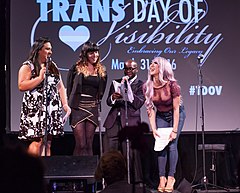|
International Transgender Day of Visibility

International Transgender Day of Visibility (often referred to as TDOV or Trans Day of Visibility) is an annual event occurring every March 31 since 2009[1][2] dedicated to celebrating transgender people and raising awareness of discrimination faced by transgender people worldwide, as well as a celebration of their contributions to society. The first International Transgender Day of Visibility was held on March 31, 2009. It has since been spearheaded by the U.S.-based youth advocacy organization Trans Student Educational Resources.[3] History and milestones2009 foundingThe event was created by transgender activist[4] Rachel Crandall Crocker of Michigan in 2009[5] as a reaction to the lack of LGBTQ+ recognition of transgender people, citing the frustration that the only well-known transgender-centered day was the Transgender Day of Remembrance, which mourned the murders of transgender people, but did not acknowledge and celebrate living members of the transgender community. President Barack Obama and Vice President Biden first acknowledged this day for the transgender community; however, at that time no proclamation was signed.[citation needed] 2014In 2014, the day was observed by activists across the world, including in Ireland[6] and Scotland.[7] 2015In 2015, many transgender individuals participated in an online social media campaign on websites including Facebook, Twitter, Tumblr, and Instagram. Participants posted selfies, personal stories, and statistics regarding transgender issues and other related content to raise awareness and increase visibility.[8] 2021In 2021, U.S. President Joe Biden proclaimed March 31 as a Transgender Day of Visibility, stating in part, "I call upon all Americans to join in the fight for full equality for all transgender people." Biden was the first American president to issue a formal presidential proclamation recognizing the event.[9][10][11] Biden issued a similar proclamation a year later, welcoming Jeopardy! contestant and transgender woman Amy Schneider to the White House and announcing a set of measures intended to support transgender rights.[12][13] 20242024 marked the 15th anniversary of Transgender Day of Visibility with celebrations planned across the globe.[14][15][16] ReceptionOver the years, Transgender Day of Visibility has had proponents and critics. Supporters of TDOV have organized a variety of responsive events. In 2024, for instance, AP reported on marches in Melbourne and Philadelphia, an "inclusive roller derby" on Long Island, and a picnic in a small English town. Some places have been lit up with trans flag colors, such as Niagara Falls.[17] To advocates of TDOV, visibility enables trans people to experience less social isolation, it "illuminates and normalizes them to the rest of the world" and it builds empathy from the cisgender majority.[18] The day is seen as a way to honor elders to trans communities, according to Shelby Chestnut of the Transgender Law Center, and "visibility means having the power and the ease to show up as all of who you are at any given moment," per Tourmaline.[19] Similarly, a trans activist originally from Belize told UNAIDS, "Visibility is power. Only when given visibility can we raise our voices and advocate for the enjoyment of our human rights." A trans interviewee from Thailand argued that TDOV could educate the public about the needs, including health care and employment.[20] It is important to show trans people flourishing, asserted Minneapolis city councilor Andrea Jenkins, during a period of violence against those with trans identities.[21] Effort to increase trans visibility have been criticized by Black abolitionists, who believe facile inclusion of trans persons in popular culture "leads to flattened understandings of Black trans life" and may endanger Black trans people. As abolitionist Miss Major Griffin-Gracy stated in 2019, "I don't really understand why we need a day of visibility, when for most of us, especially us Black girls, we are as visible as we need to be. Our visibility is getting us killed."[22] Similarly, some scholars argue that over-exposure of trans people can result in erasure, by virtue of perpetuating stereotypes or reducing people to statistical measures.[22] Besides the paradox of visibility as a physical risk, others question whether TDOV is offering a "sanitized image of transgender people" that reinstantiates socioeconomic and racial exclusions.[23] In 2024, TDOV coincided with the Christian holiday of Easter that year. U.S. President Biden's support of TDOV was condemned by some Christian Republicans, which caused a brief political "controversy, which has galvanized conservatives and which transgender advocates say is manufactured."[24] [25][26] References
External linksWikimedia Commons has media related to Transgender Day of Visibility.
|
|||||||||||||||||||||||||||||||||
